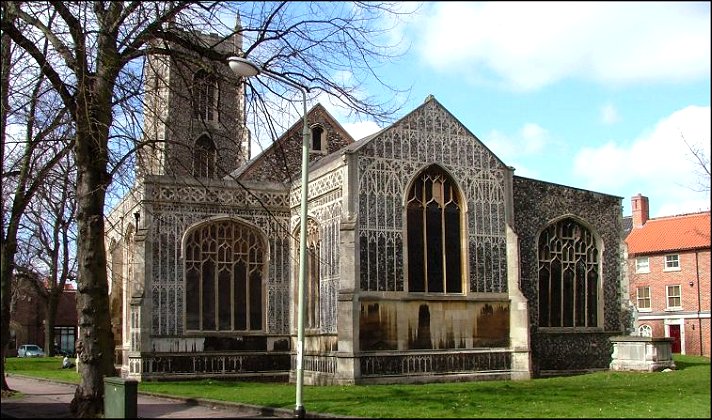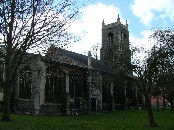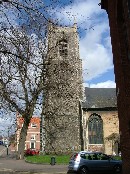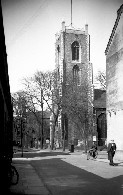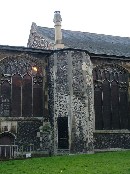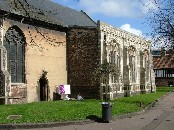| |
|
St
Michael Coslany, Norwich
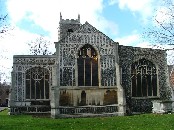 |
|
This
church is no longer in use for anything. When I
visited in 2006 it was the Inspire Discovery
Centre. In 2006, I wrote: St Michael at Coslany
is perhaps the most elegant and beautiful of the
Norwich city centre churches. Here is early 16th
century Perpendicular in all its glory, with
stunning flushwork across the east end and the
aisles. We'll come back to this in a minute. The
south aisle is curious, because the west end of
it is one bay short of the north aisle's west
end. There must have been a simply enormous
two-storey porch here at one time. Coslany was
the heart of industrial inner-city Norwich, home
to the city's biggest brewery and some of the
world's largest shoe factories; but today, what
survives of these buildings has been converted
into hi-tech offices and trendy flats.
|
As we
approached the church, a little truck, looking a little
like an ice cream van, came to a halt beside us, and
began playing the Harry Lime theme. It wasn't selling ice
creams, but sandwiches and coffee to office workers.
St Michael
is sometimes abbreviated to St Miles, and is recorded
that way in old documents. There were four churches
dedicated to St Michael in the city, but St Miles always
means this one. George Plunkett came this way on the last
day of March 1938, and his photographs show a rather
dour, urban Victorianised interior, probably fairly low
church for Norwich. Today, the church is the home of the
Inspire Discovery Centre, a 'hands-on' science
exhibition, and the colourful interior is a dramatic
contrast with that of nearly seventy years ago.
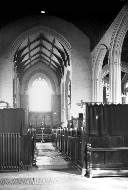 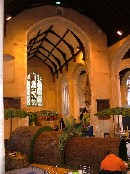 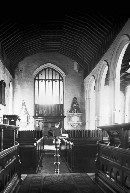 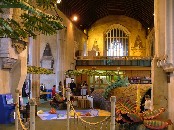
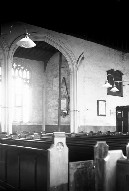 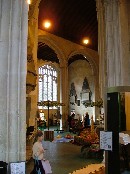 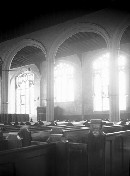 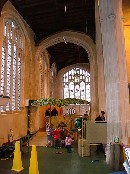
in 1938, the main
entrance was from the west, but this is now closed off.
The area beneath the tower has been restored as a fine
bell-ringing chamber, and these bells still ring out
regularly across the city. In the west end of the nave,
are the offices, kitchen and toilets of the science
centre, forming a kind of balcony which is not accessible
by the public, but seems to be used for storage. This
structure, in fact, predates Inspire; for several years
after redundancy in the 1970s, this building acted as a
gymnasium for the Duke Street youth centre, and it was
then that the balcony area was built to provide changing
rooms. The balcony rail cuts rather awkwardly into the
royal arms.
You may think that the graveyard is rather
short of headstones. This is partly because, until the
end of the 19th century, what we now see as a large
rectangle of green actually had several buildings in it.
The east end of the chancel was blocked off, and the only
light came through the aisle windows.
| In
the 1880s, the buildings were cleared and the
east end of the chancel was rebuilt. Thus, the
flushwork, which matches that of the aisles, is
actually a piece of clever Victorian counterfeit.
Spencer and Kent say that the work was carried
out by one William Hubbard of Dereham. Stepping
inside today, the main impression is of white
lightness. As at St George Colegate next door, it
is like being inside a vast, square glasshouse.
The pillars of the arcades are narrow and tall,
and the aisle walls beyond echo them with a
series of blank arcades, as though you might
expect another aisle beyond them. Although the
church is, I am afraid, very dirty above head
height, there is still a sense of whiteness, of
lightness; I don't believe that this church ever
had wall paintings and decorations, except above
the chancel arch.
|
|
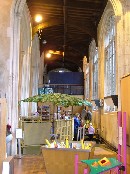 |
In the
early 16th century, money for the elaboration of the
church had been bequeathed by members of the Clerk, Thorp
and Ramsey families. All the glass of that time has gone
now, pretty much; there are a few surviving fragments
reset in the east window of the north aisle, mainly
canopy work. In the east window of the chancel, the
Victorians placed a large deposition from the cross,
which looks as if it might be continental work, or
perhaps simply another clever Victorian counterfeit.
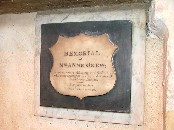 |
|
All
furnishings have been removed, presumably because
as much space was wanted as possible when the
building was a sports centre. However, many of
the memorials survive, collected in the south
aisle and on the chancel arch. There are also two
massive ones up in the gallery; if you compare
George Plunkett's photograph of the west end to
mine of 2006, you can see that these have both
been moved up the wall to accomodate the gallery. Curiously,
of the two on the west wall of the south aisle to
Thomas Wigg and Richard Boardman, only Boardman's
appears in the 1938 photograph, so presumably the
Victorians were not responsible for moving them
all to their present positions.
|
In the
east end of the north aisle is what appears to be the
remains of a late 16th or early 17th century memorial
bearing the name Henry Fawcett. My favourite of all is a
little one one on the north side of the chancel arch that
reads simply: Memorial of Mrs Anne Grew, who died
very suddenly on the 17th October 1844, while conversing
with her husband W. Grew, of Duke Street, Norwich -
Corpore Mortua, sed Memoria viveris ('her body is
dead, but she lives on in the memory').
| Inspire
itself is worth a visit if you have children,
although the staff are not terribly keen on you
taking photographs, especially if you are a man.
Entrance fees seem ambitiously high, perhaps to
keep the riff-raff out, but as the father of two
well-behaved middle class children myself I was
pleased to take them with me and let them explore
while I photographed the building. As you may
imagine, it was not long before I was tapped on
the shoulder and asked what I was doing, but I
promised to try not to get anyone elses' children
into the shots, and this seemed to appease her.
The
Inspire Discovery Centre has since closed,
although obviously I take no credit for this.
|
|
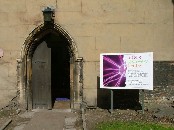 |
Simon Knott, April 2006, updated October
2016
|
|
|

